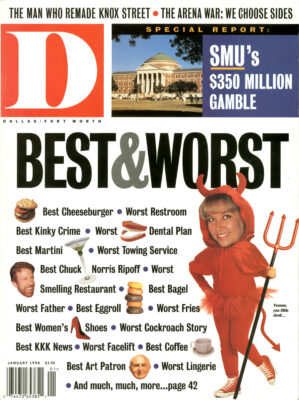IN 1910, the Hilltop was surrolnded by nothing more than a field of Johnson grass accented by scatterings of scrub hackberry and bois d’arc trees. When Robert S. Hyer, SMU’s first president, took his family out on a bumpy dirt road to view the site of his dream for a new university, Mrs. Hyer is said to have wept tears of despair.
The original plan was to steal Southwestern University from Georgetown, near Austin. Methodists were losing control of Vanderbilt University, and church leaders feared the poorly financed and unsuitably located Southwestern would be an inadequate substitute. Hyer, then president of Southwestern, had his sights on Dallas, and when momenturn began to build for the construction of a grand rotunda at Georgetown, Hyer hinted strongly to Dallas leaders that the university could be bought. On May 27, 1910, streamers were hung across Main Street in downtown Dallas proclaiming that a great university could be had that would bring thousands of students and “millions of money.” Within a few days, the town fathers had extracted enough pledges to make a bid, but the collective opposition from South and Central Texas, as well as from prohibitionists who noted that saloons were outlawed in Georgetown, was sufficient to squelch the move.
In the meantime. Fort Worth decided it would like to be the Southern capital of higher learning for Methodists. Succumbing to this added pressure, church leaders decided to leave Southwestern where it was and build a new university in North Texas, with the site to go to the highest bidder. Fort Worth offered $400,000 in cash and 600 acres of land. Dallas’ best offer was $300,000 and 300 acres, but after the bidding deadline closed, the church people let the Dallas group add land to their proposal that they had wheedled out of pioneer settler W. W. Caruth. The official nod went to Dallas, inspiring a cartoon in the Fort Worth Star-Telegram of the rival cities at a poker table with Dallas having a clear view of the Cowtown hand through a mirror behind the opposing chair.
After rejecting suggestions to call the new school Texas Wesleyan, Southland, or Trans-Mississippi, it was agreed that the seat of higher learning would be called Southern Methodist University. With houses and buildings now blocking the view from the distance, the university hilltop is not as striking as it once was, but the SMU campus is actually one of the highest points in Dallas County. When the site was selected in 1910, the crest of the hilt was on a nearly exact plane with the top of the Praetorian Building, the city’s tallest building at 16 stories. Dallas Hall is, of course, still the focal point of the campus; when the university opened, this was the campus, except for the women’s dorm and temporary buildings used to house male students.
Dallas Hall, so named because of the financial support of a religious cross section of the local citizenry, was architecturally inspired by the Roman Pantheon and influenced by Jefferson’s library at the University of Virginia. A contract was let in 1912 to build the rotunda for $212.902, but the contractor went broke and pledges dwindled. The school did not open its doors until 1915, two years behind schedule. Even then the administrative staff was unprepared. Expecting 300 students, more than 400 showed up the first week, and classes were delayed several days.
Commuting students rode the trolley to the end of the line at Knox Street, then boarded the “Dinkey,” a special streetcar operated by a driver known only as “Dad” and designed to transport 20 students at a time up the hill to Dallas Hall. When the Dinkey ran off track, as it often did (it could reach speeds upward of 10 miles an hour), it was the responsibility of the passengers to right it. The dorms were more convenient, but at a sacrifice of freedom. Female students were prohibited from leaving the campus unchaperoned and were required to nap on Sunday afternoon.
Dallas Hall featured a barber, a shoe shine parlor, a post office, and a telephone switchboard. Jack Taylor, operator of the campus bookstore, was known among the students as “Hijack.” The smell of onions rising from the burger grill in the basement mixed with the wafting odor of formaldehyde from the biology lab, leaving a memorable sensory impression on the early matriculates.
Hyer was branded a turncoat by the people of Georgetown for fomenting the notion of a new university in Dallas, and before leaving Southwestern, he was afraid to go out after dark for fear of being egged. The architectural integrity and flowing symmetry of the SMU campus is attributable to his refined taste and remarkable foresight. During the entire time he headed SMU, he doubled as a full-time physics professor, but in 1920, he was forced to resign the presidency because of shortcomings as a fund-raiser.
Related Articles

Business
Executive Travel: Beverly Hills, California
The Maybourne Beverly Hills is a luxurious home base to explore the best of Los Angeles, a frequent destination of Alto CEO Will Coleman.
By Will Maddox

Hot Properties
Hot Property: An Architectural Gem You’ve Probably Driven By But Didn’t Know Was There
It's hidden in plain sight.
By Jessica Otte


